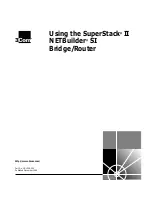
12.6
Loop detection
With the "Loop detection" function, you specify the ports for which loop detection will be
activated. The ports involved send special test frames - the loop detection frames. If these
frames are sent back to the device, there is a loop.
A "Local loop" involving this device means that the frames are received again at a different
port of the same device. If the sent frames are received again at the same port, there is a
"remote loop" involving other network components.
With the commands in this section, you start loop detection and decide which actions will be
used on the ports affected if loops are detected.
Note
A loop is an error in the network structure that needs to be eliminated. The loop detection can
help to find the errors more quickly but does not eliminate them.
Note
Note that loop detection is only possible at ports that were not configured as ring ports or
standby ports.
Note
Changing the configured port status with loop detection
The configuration of the port status can be changed with the "Loop Detection" function. If, for
example, the administrator has disabled a port, the port can be enabled again after a device
restart by "Loop Detection". The port status "link down" is not changed by "Loop Detection".
12.6.1
The "show" commands
This section describes commands with which you display various settings.
12.6.1.1
show loopd
Description
With this command, you display the information on loop detection.
Detected loops are shown.
Requirement
You are in the User EXEC mode or in the Privileged EXEC mode.
Diagnostics
12.6 Loop detection
SCALANCE XB-200/XC-200/XF-200BA/XP-200/XR-300WG Command Line Interface
598
Configuration Manual, 07/2017, C79000-G8976-C361-06
















































